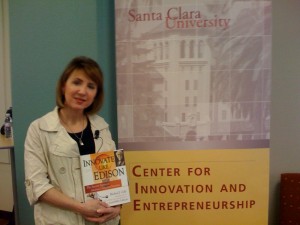INNOVATE LIKE EDISON
/
One of the benefits of living in the Silicon Valley is the ability to interact with the world's great innovation experts. Early in the week it was Vint Cerf at Stanford, and today, at my own Santa Clara University, Sarah Miller Caldicott. Ms. Caldicott is founder of Power Patterns of Innovation, co-author of Innovate Like Edison: The Success System of Americas Greatest Inventor -- and a great grand niece of Thomas Edison - holder of 1093 patents.
We need some perspective to understand Edison's innovation contributions. Edison created the first R&D laboratory (Menlo Park) with a "systematic approach to innovation." Evidence that his methods work: A 1919 New York Times article reported:
Ms. Caldicott is founder of Power Patterns of Innovation, co-author of Innovate Like Edison: The Success System of Americas Greatest Inventor -- and a great grand niece of Thomas Edison - holder of 1093 patents.
We need some perspective to understand Edison's innovation contributions. Edison created the first R&D laboratory (Menlo Park) with a "systematic approach to innovation." Evidence that his methods work: A 1919 New York Times article reported:
 Ms. Caldicott is founder of Power Patterns of Innovation, co-author of Innovate Like Edison: The Success System of Americas Greatest Inventor -- and a great grand niece of Thomas Edison - holder of 1093 patents.
We need some perspective to understand Edison's innovation contributions. Edison created the first R&D laboratory (Menlo Park) with a "systematic approach to innovation." Evidence that his methods work: A 1919 New York Times article reported:
Ms. Caldicott is founder of Power Patterns of Innovation, co-author of Innovate Like Edison: The Success System of Americas Greatest Inventor -- and a great grand niece of Thomas Edison - holder of 1093 patents.
We need some perspective to understand Edison's innovation contributions. Edison created the first R&D laboratory (Menlo Park) with a "systematic approach to innovation." Evidence that his methods work: A 1919 New York Times article reported:
It has been estimated that there are a thousand million dollars invested in the industries which he has either created or for which he has laid part of the foundation; and a million employees are in these industries.He established 6 industries (in 40 years):
- Document duplication (1873)
- Telecommunications (1876)
- Recorded sound (1877)
- Electrical power (1879)
- Motion pictures (1893)
- Portable power (1905)
- Solution-centered Mindset: (she says most important) Imagine the solution, then get ahead of it, and use experiments to nail it down. Edison conducted over 10,000 experiments in the first year of working on the storage battery.
- Kleidoscopic thinking: went beyond brainstorming - whole brain thinking. "To have a great idea, have a lot of them." Once he invented the light bulb, he had to invent the system to run them. He looked to telegraphy and electricity (multiple streams of knowledge). He drew six pictures and one became the first electric circuit. Use fantastical storytelling (dropping self censorship by getting your brain to think in fiction form).
- Full-spectrum Engagement: Important to work in solitude, and also important to work in teams. Opposites -- important to be intense, but also to relax. Sharing and protection.
- Master-mind collaboration: Cross functional teams, organizational design (org and physical structure) that enabled ad hoc interaction across expertise areas -- in the late 1800s!
- Super-value creation: Ethnographic research to understand the market. "A believer in going and looking." Creation of a brand.







